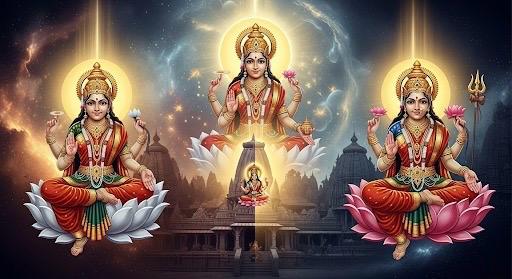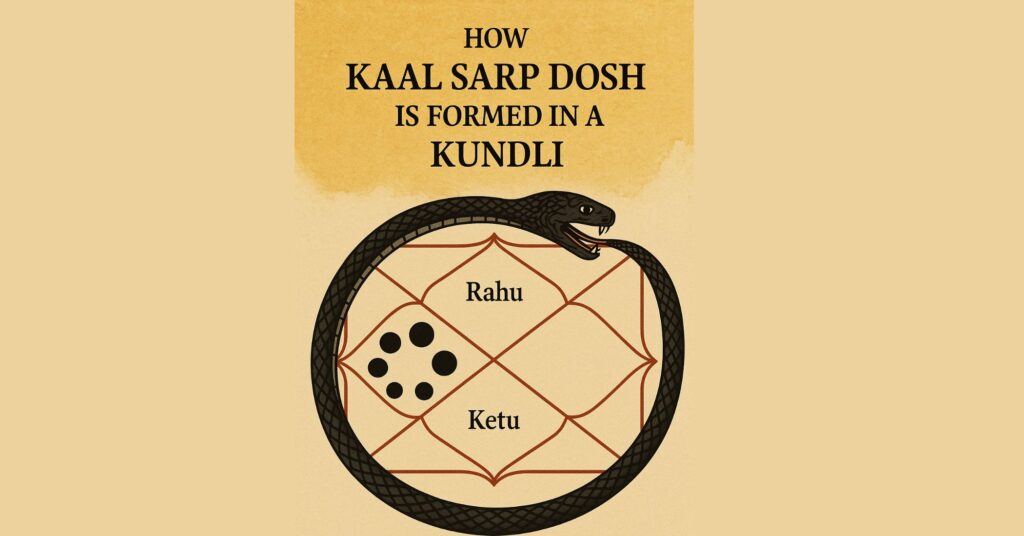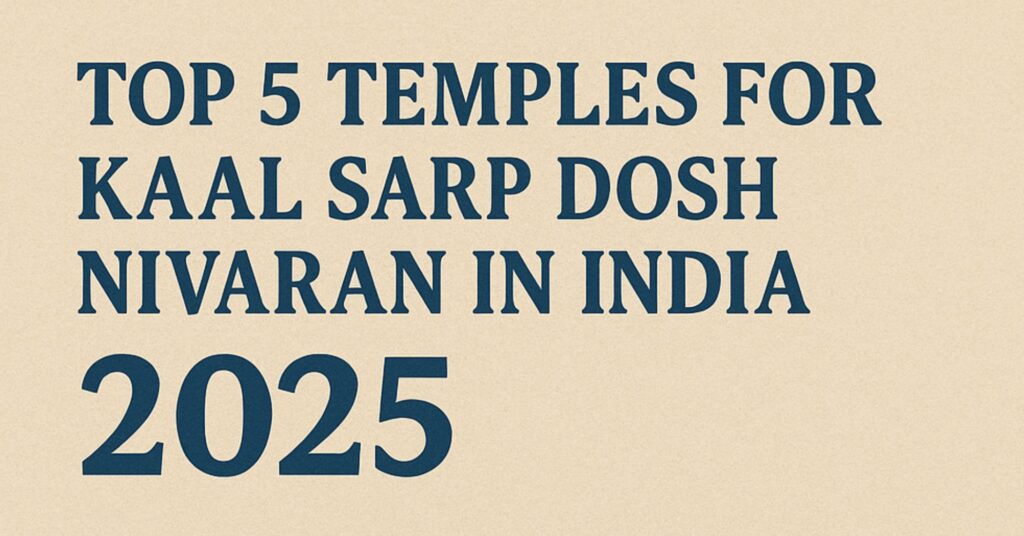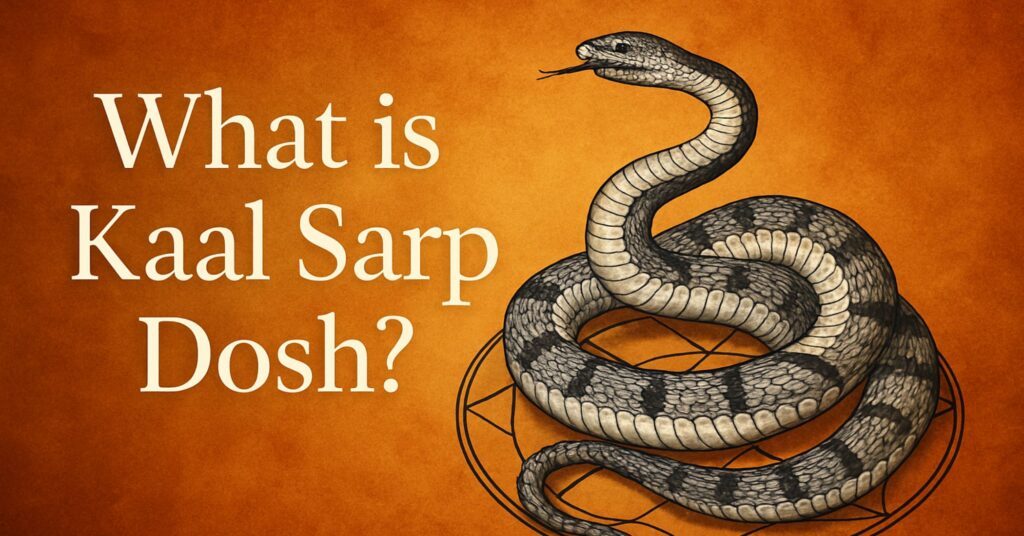India is a country of spirituality, faith, and divine energy. Shakti Peethas have a unique place. These sacred shrines are devoted to Goddess Shakti, the divine feminine power, and are found all over India and even outside. Legends say that there are 51 major Shakti Peethas, and each one of them is highly spiritually significant. There is a special tradition of worshipping the 3 and a Half Shakti Peeth (Teen Sade Teen Shakti Peeth). These temples are the most potent seats of divine feminine power in the state and are worshipped by millions of pilgrims.
Here, we will be checking out what these holy Shakti Peeths are, what their history is, their religious importance, and why they matter so much for devotees. We will be mentioning the importance of an experienced guru to lead devotees through rituals and pujas, and we’ll be ending with the mention of Shivendra Guru Ji, who is considered to be one of the finest pandits in Trimbakeshwar.
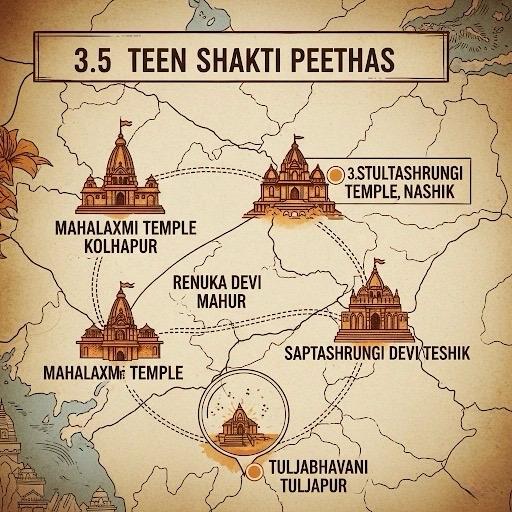
What are the 3 and Half Shakti Peeth?
The Teen Sade Teen Shakti Peeths of Maharashtra are:
Mahalakshmi Temple, Kolhapur
Tulja Bhavani Temple, Tuljapur
Renuka Devi Temple, Mahur
Saptashrungi Devi Temple, Vani (the half Peeth)
All the temples have behind them intriguing legends, divine power, and intense faith among the devotees. Let’s examine them in detail.
1. Mahalakshmi Temple, Kolhapur
Situated in Kolhapur, this temple is among the most significant Shakti Peeths of India. Goddess Mahalakshmi, or Ambabai, is worshipped here. Her eyes had fallen at this place, as per legend, when the body of Goddess Sati was broken into pieces all over the earth.
Significance
According to belief, Mahalakshmi grants prosperity, prosperity, and divine happiness to her devotees. The temple is also one of the Ashtadasa Shakti Peethas referred to in ancient religious texts.
Unique Feature
The Mahalakshmi idol is oriented westward, which is different from most temples in which deities are oriented eastward. The devotees believe that this refers to her perpetual preparation to bless her devotees.
2. Tulja Bhavani Temple, Tuljapur
Situated at Tuljapur (Osmanabad district), this temple is in honour of Goddess Bhavani, which is a fierce incarnation of Shakti. She is the Kuldevi (family goddess) of numerous families in Maharashtra, including the great Maratha king Chhatrapati Shivaji Maharaj.
Significance
Goddess Tulja Bhavani is revered as the destroyer of evil forces and the bestower of strength, courage, and protection. Shivaji Maharaj is believed to have been blessed with the Bhavani sword (Tulja Bhavani Talwar) by the goddess herself, which greatly contributed to his conquests.
Unique Feature
The temple welcomes lakhs of devotees, particularly during Navratri, when special processions and rituals take place.
3. Renuka Devi Temple, Mahur
In Mahur, Nanded district, the Renuka Devi Temple is built in honour of Goddess Renuka, mother of Lord Parashurama, the sixth avatar of Lord Vishnu.
Importance
Renuka Devi is considered a representation of motherhood, love, and compassion. People worship here for family health, marital bliss, and safeguarding children.
Special Feature
Mahur is also regarded as the three and a half jyotirlingas of Maharashtra and thus doubly revered as a Shakti Peeth and Jyotirlinga area.
4. Saptashrungi Devi Temple, Vani (The Half Peeth)
Located in Vani, Nashik district, this temple is referred to as the “half” Shakti Peeth. Goddess Saptashrungi dwells among the seven hills, and thus the name.
Significance
The goddess is said to have appeared here to kill the demon Mahishasura. People believe that she grants the wishes of everyone who ascends the 500 steps to her shrine.
Unique Feature
The temple’s holy site in the Sahyadri hills and the strong aura of the goddess make it a spiritually enlightening location.
Why are They Called 3 and a Half Shakti Peeth?
The initial three temples (Kolhapur, Tuljapur, and Mahur) are complete Peeths, whereas Saptashrungi at Vani is a half Peeth. This classification is based on ancient scriptures, wherein the power of divine energy was explained differently for every site. Nevertheless, the “half Peeth” in Vani is also equally worshipped and has lakhs of pilgrims visiting it annually.
Spiritual Significance of a Pilgrimage to the 3 and Half Shakti Peeths
Granting of Wishes
People have faith that prayer at these temples is never in vain, as long as it is prayed with sincerity.
Protection from Evil
The goddess is revered as the annihilator of evil forces and negative energies.
Prosperity and Good Health
People pray for financial success, good health, and well-being.
Spiritual Development
A visit to such temples is regarded as a crucial pilgrimage that boosts devotion and inner strength.
Cultural Significance
These temples are an integral part of Maharashtra’s spiritual and cultural heritage, with strong historical and traditional ties.
Festivals and Rituals at the Shakti Peeths
Navratri
All the Shakti Peeths celebrate the nine-day festival of the goddess grandly. Special processions, rituals, and cultural events are organised.
Chaitra Purnima
At Saptashrungi Devi, it is celebrated grandly with lakhs of devotees visiting to pray.
Special Offerings
Sarees, ornaments, sweets, and coconuts are offered by devotees to the goddess as a sign of appreciation.
Conclusion
The 3 and a Half Shakti Peeths of Maharashtra are not mere temples; they are a hub of enormous spiritual energy, devotion, and cultural traditions. A visit to these temples infuses devotees with divine blessings, eradicates obstacles, and reinforces their spiritual path.
While doing so, several individuals also experience astrological doshas such as Kaal Sarp Dosh, which need specific remedies by performing sacred rituals. For this reason, to ensure the rituals are done in an authentic and Vedic way, guidance from a seasoned guru is imperative.
Among the world-renowned gurus in Trimbakeshwar, Shivendra Guru Ji is one of the most suitable pandits for Kaal Sarp Puja. With years of experience, profound scriptural expertise, and selfless service to devotees, he has relieved countless families from doshas and helped them live a serene, prosperous life.
One of the most seasoned and reliable pandits for Kaal Sarp Dosh Puja in Trimbakeshwar, he is renowned for conducting the rituals with full Vedic practices and dedication. Book your Narayana Bali Pooja with an experienced and knowledgeable Pandit for authentic rituals and peace of mind. Contact us !
Author: Shivendra Guru Ji
For an accurate and authentic puja, Shivendra Guru Ji is the best pandit for Kaal Sarp Puja in Trimbakeshwar. With years of experience and unmatched spiritual discipline, he ensures each ritual is conducted with precision, sanctity, and divine energy.
Feel free to connect with me on Instagram, and book your Kalsarp Dosh Shanti Pooja at Trimbakeshwar Temple in Nashik with an experienced and knowledgeable Pandit for authentic rituals and peace of mind.
Bonus Tips – Best pandit for kaal sarp puja in trimbakeshwar
FAQs on 3 and Half Shakti Peeth
1. How many Shakti Peeths ?
There exist the popular 3 and Half Shakti Peeths – Saptashrungi, Tuljapur, Mahur, and Kolhapur in Maharashtra.
2. Why is Saptashrungi Devi referred to as a half Peeth?
As per scriptures, the divine power here is half as compared to the other three complete Peeths, but spiritually it is as efficacious.
3. Which goddess was Shivaji Maharaj’s deity?
Chhatrapati Shivaji Maharaj was a tremendous worshipper of Tulja Bhavani and believed in her as his Kuldevi.
4. What is the best time to come to these Shakti Peeths?
The best time is during Navratri and other prominent Hindu festivals, but pilgrims visit at any time of the year.
5. Are these temples related to Kaal Sarp Dosh remedies?
Indirectly, yes. The worship of the goddess eliminates obstacles, negativity, and karmic problems. But for specific remedies for Kaal Sarp Dosh, rituals such as Narayan Nagbali or Kaal Sarp Pooja at Trimbakeshwar are advised.
